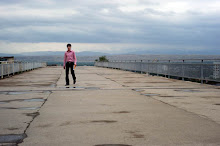Tashkent is one helluva tough town. I thought it was going to be my kind of photography scene-- filled with ugly beauty. Early indications seemed promising when Vivian and I walked by this cafe near our hotel.

"Dadu" is what Tobey and Caleb call me. Vivian took this as I proudly stood out front.
Before I start complaining, here's a list of things I like about Tashkent:
1. The hotel, with live harp music every morning at a good buffet breakfast, plus free in-room wireless.
2. The American Embassy and their outstanding operatives. I really think these guys are altruistically contributing to Uzbekistan's overall well-being.
3. Food that, even when it was bad, was good enough to eat. This includes coffee that wasn't instant and J Smoker's local draft dark beer, which was real good.
4. Taxi anywhere in the city for less that $3. Almost any vehicle is a taxi. You just stick your hand out wherever you are. Someone will stop within about a half dozen cars. You do a quick negotiation and if they aren't interested, there is another car that has moved in behind the first.
The city seems to not be user friendly. Unfortunately, it was destroyed in 1966 by an earthquake. The Soviet Union rebuilt it with the participation of every Soviet state. This meant that a potpourri of oversized structures, built by a variety of people, created a city of big, bulbous, (mostly) empty interiors and large grass, or cement, filled spaces in between. It's an unenviable experience to be staggering around in 100 degree heat between these buildings. Each guarded proletarian fortress seems to be spaced about a half mile apart. It's kind of like the architecture of UMass except you can't walk anywhere, there is no place to go on foot. The sidewalks are fenced-in so you can barely even get across the street. The roads include around 5 traffic lanes in each direction, plus trolleys. Crossing the street requires the tenacity of a demolition derby driver (without a car).
Nobody in town knows anything about where they are or where you may want to be going. They will give you directions unhesitatingly even though they have no idea what you are asking about. We have never received accurate directions from a person on the street, unless he was driving you there. In that case, it was his gas that he was wasting so he'd figure it out.
That said, the people of Tashkent are very nice. My attempts to make portraits are usually met with one of two responses.

An undesirable smile.... or a, "talk to the hand!"

So, now you know why the 1000 words. I would rather show you a picture.
I did make one picture that I like.

In lieu of posting more good pictures (that I didn't make), here's the illustrated story of our carpet.
The carpet shop was behind a signless doorway in one of those huge buildings I was talking about. The dealer invited us in off the street, led us through a room where a few old guys were drinking tea, then through a very small room with a metal desk and a piano.

Next, through a slightly bigger cement walled chamber-- the showroom.

and finally into a couple of connected closets lined with folded carpets.

That's Nadira behind Vivian. Here she is in the showroom.

The long process of looking at too many carpets is more fun than choosing tile and superior to watching paint dry. Vivian is checking the color of this carpet with her toenail polish.

We finally pick the best combination of the usual factors and end up with this Bukhara design on an Afghan made beauty.

Vivian's name is up in the corner because we are doing the paperwork to get it out of the country. That's a post for another time.
 I don't think I'll be posting much more on Asia Central. Blogspot simply is not as easy to use as Wordpress. I have not felt comfortable with the Blogger software.
I don't think I'll be posting much more on Asia Central. Blogspot simply is not as easy to use as Wordpress. I have not felt comfortable with the Blogger software.
























































